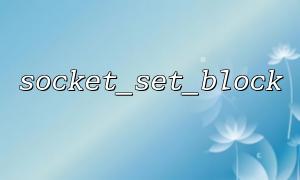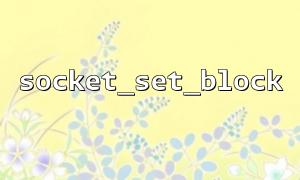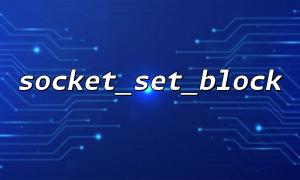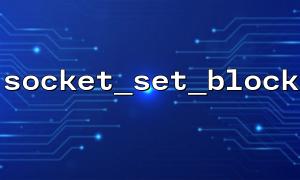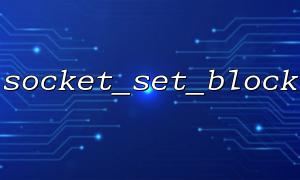When programming Socket with PHP, developers sometimes encounter problems such as calling socket_set_block() or socket_set_nonblock() does not seem to work, and the Socket behavior does not match expectations. There may be many reasons for this situation. This article will explore the common reasons why this function is "invalid" and provide corresponding troubleshooting suggestions.
First, make sure that before calling socket_set_block() , socket_create() returns a valid Socket resource. If the Socket creation fails, such as due to parameter errors, insufficient system resources or permissions, subsequent operations on the Socket will naturally not take effect.
$socket = socket_create(AF_INET, SOCK_STREAM, SOL_TCP);
if ($socket === false) {
die("Socket Creation failed: " . socket_strerror(socket_last_error()));
}
socket_set_block($socket);
Ensuring that error detection is not ignored is the first step in troubleshooting such problems.
In some cases, the Socket resource may have been closed or is in an invalid state when socket_set_block() is called. For example, calling the blocking setting function will have no effect after the remote host closes the connection.
You can use socket_get_status() or monitor the connection status to avoid setting blocking mode in an invalid state.
In PHP, functions such as stream_socket_client() are often used to create resources. It returns stream, not native Socket resources. In this case, socket_set_block() cannot be used to control the blocking mode, but stream_set_blocking() should be used.
$stream = stream_socket_client("tcp://gitbox.net:80", $errno, $errstr, 30);
if (!$stream) {
die("Connection failed: $errstr ($errno)");
}
stream_set_blocking($stream, true); // Correct blocking setup method
Mixing different types of resources and functions is one of the common reasons why setup failures.
In some system implementations, once the socket_connect() call is completed, the Socket status may be affected, resulting in the socket_set_block() setting not being fully applied. Especially in non-blocking connection scenarios (for example, if you want to set it to non-blocking for connection), and then you want to set it to block, it may not take effect immediately.
It is recommended to ensure that the blocking/non-blocking settings are completed before calling socket_connect() , or to reevaluate the connection establishment logic.
Some systems have special treatments on Socket blocking behavior, especially in secure environments such as certain restricted containers, SELinux settings, or open_basedir restrictions, which may prevent some Socket settings behavior. Using socket_last_error() and log monitoring can help confirm such problems.
If you encounter invalid blocking settings when using multithreaded extensions (such as pthreads) or coroutine frameworks (such as Swoole), it is likely that the framework encapsulates the underlying I/O model and the native socket_set_block() cannot take effect. At this time, refer to the I/O control method provided by the framework.
For example, it is recommended to use $socket->setBlocking(true) instead of PHP native Socket function.




